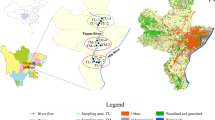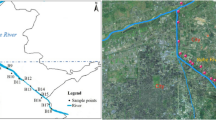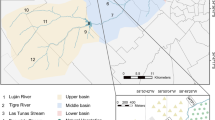Abstract
Channel confluences are common in urban rivers and caused complex hydrodynamic conditions in the downstream section, significantly influencing the distribution of pollutants and the microbial community. So far, the principles of bacterial community assembly and their linkages with environmental factors are poorly understood. In the present study, the hydrodynamic and pollution conditions were investigated in a typical channel confluence of an urban river in the Yangtze River delta area, China, and their impacts on the bacterial community structure in the water and sediment were characterized using 16S rRNA gene high-throughput sequencing technology. Based on the results, the flow velocity was the crucial factor influencing the dispersal of nutrients, organic compounds, and bacterial communities in the river water. Moreover, the sediments exhibited higher α-diversity and bacterial richness for nitrogen and sulfur cycling than the water. In addition to flow velocity, the contents of total organic carbon, total phosphorus, and heavy metals determined the sediment bacterial communities at varying depths. The predictive analysis of functional gene category indicated differences between the water and sediment communities in metabolic potentials and pathogen risk and provided guidance for water pollution control and the eco-remediation of urban rivers.








Similar content being viewed by others
Data availability
All data generated or analyzed during this study are included in this published article.
References
American Public Health Association (APHA) (1998) Standard methods for examination of water and wastewater. 20th ed
Avila MP, Brandao LPM, Brighenti LS, Tonetta D, Reis MP, Staehr PA, Asmala E, Amado AM, Barbosa FAR, Bezerra-Neto JF, Nascimento AMA (2019) Linking shifts in bacterial community with changes in dissolved organic matter pool in a tropical lake. Sci Total Environ 672:990–1003
Bao SJ, CAP (2008) Soil agro-chemistrical analysis. China Agric Press 585:586
Burton GA, Johnston EL (2010) Assessing contaminated sediments in the context of multiple stressors. Environ Toxicol Chem 29(12):2625–2643
Cai W, Li Y, Shen Y, Wang C, Wang P, Wang L, Niu L, Zhang W (2019) Vertical distribution and assemblages of microbial communities and their potential effects on sulfur metabolism in a black-odor urban river. J Environ Manage 235:368–376
Cai W, Li Y, Hu J, Cheng H (2021) Exploring the microbial ecological functions in response to vertical gradients in a polluted urban river. Clean-Soil Air Water 49(9):2100004
Cieniawski S, Macdonald DD, Ingersoll CG (2002) A guidance manual to support the assessment of contaminated sediments in freshwater ecosystems. US Environmental Protection Agency, Great Lakes National Program Office
Crump BC, Amaral-Zettler LA, Kling GW (2012) Microbial diversity in arctic freshwaters is structured by inoculation of microbes from soils. ISME J 6(9):1629–1639
Deveautour C, Rojas-Pinzon PA, Veloso M, Rambaud J, Duff AM, Wall D, Carolan R, Philippot L, Richards KG, O’Flaherty V, Brennan F (2022) Biotic and abiotic predictors of potential N2O emissions from denitrification in Irish grasslands soils: a national-scale field study. Soil Biol Biochem 168:108637
Gao Y, Zhang W, Li Y (2021) Microbial community coalescence: does it matter in the Three Gorges Reservoir? Water Res 205:117638
General Office of Jiangsu Provincial Government (GOJPG) (2021) Jiangsu Province's “14th Five-Year Plan” for ecological environmental protection (2021–2025)
Haller L, Tonolla M, Zopfi J, Peduzzi R, Wildi W, Pote J (2011) Composition of bacterial and archaeal communities in freshwater sediments with different contamination levels (Lake Geneva, Switzerland). Water Res 45(3):1213–1228
Hollister EB, Engledow AS, Hammett AJ, Provin TL, Wilkinson HH, Gentry TJ (2010) Shifts in microbial community structure along an ecological gradient of hypersaline soils and sediments. ISME J 4(6):829–838
Huguet A, Vacher L, Relexans S, Saubusse S, Froidefond JM, Parlanti E (2009) Properties of fluorescent dissolved organic matter in the Gironde Estuary. Org Geochem 40(6):706–719
Hui C, Li Y, Zhang W, Yang W, Wang W, Gao Y, Niu L, Wang L, Zhang H (2021) Coupling genomics and hydraulic information to predict the nitrogen dynamics in a channel confluence. Environ Sci Technol 55(8):4616–4628
Hui C, Li Y, Liao Z, Zhang W, Zhang H, Niu L, Wang L (2022) Confluences characteristics determine the influence scope of microbial community from confluence hydrodynamic zone on river network. J Hydrol 612:128288
Ji B, Shi Y, Yılmaz M (2022) Microalgal-bacterial granular sludge process for sustainable municipal wastewater treatment: simple organics versus complex organics. J Water Proc Eng 46:102613
Jiang M, Sheng Y, Liu Q, Wang W, Liu X (2021) Conversion mechanisms between organic sulfur and inorganic sulfur in surface sediments in coastal rivers. Sci Total Environ 752:141829
Lei M, Li Y, Zhang W, Niu L, Wang L, Zhang H (2020) Identifying ecological processes driving vertical and horizontal archaeal community assemblages in a contaminated urban river. Chemosphere 245:125615
Li Y, Wang C, Zhang W, Wang P, Niu L, Hou J, Wang J, Wang L (2015) Modeling the effects of hydrodynamic regimes on microbial communities within fluvial biofilms: combining deterministic and stochastic processes. Environ Sci Technol 49(21):12869–12878
Li Y, Hui C, Zhang W, Wang C, Niu L, Zhang H, Wang L (2020a) Integrating microbial community assembly and fluid kinetics to decouple nitrogen dynamics in an urban channel confluence. Environ Sci Technol 54(18):11237–11248
Li C, Quan Q, Gan Y, Dong J, Fang J, Wang L, Liu J (2020b) Effects of heavy metals on microbial communities in sediments and establishment of bioindicators based on microbial taxa and function for environmental monitoring and management. Sci Total Environ 749:141555
Li W, Zhuang JL, Zhou YY, Meng FG, Kang D, Zheng P, Shapleigh JP, Liu YD (2020c) Metagenomics reveals microbial community differences lead to differential nitrate production in anammox reactors with differing nitrogen loading rates. Water Res 169:115279
Liu T, Zhang AN, Wang J, Liu S, Jiang X, Dang C, Ma T, Liu S, Chen Q, Xie S, Zhang T, Ni J (2018) Integrated biogeography of planktonic and sedimentary bacterial communities in the Yangtze River. Microbiome 6(1):16
Liu Q, Liu HC, Zhou YG, Xin YH (2019) Stenotrophobium rhamnosiphilum gen. nov., sp. Nov., isolated from a glacier, proposal of Steroidobacteraceae fam nov. in Nevskiales and emended description of the family Nevskiaceae. Int J Syst Evol Microbiol 69(5):1404–1410
Massara TM, Malamis S, Guisasola A, Baeza JA, Noutsopoulos C, Katsou E (2017) A review on nitrous oxide (N2O) emissions during biological nutrient removal from municipal wastewater and sludge reject water. Sci Total Environ 596–597:106–123
Meziti A, Tsementzi D, Kormas KAR, Karayanni H, Konstantinidis KT (2016) Anthropogenic effects on bacterial diversity and function along a river-to-estuary gradient in Northwest Greece revealed by metagenomics. Environ Microbiol 18(12):4640–4652
Ning D, Huang Y, Pan R, Wang F, Wang H (2014) Effect of eco-remediation using planted floating bed system on nutrients and heavy metals in urban river water and sediment: a field study in China. Sci Total Environ 485–486:596–603
Nyoyoko VF (2022) Proteobacteria response to heavy metal pollution stress and their bioremediation potential. Cost Effective Technologies for Solid Waste and Wastewater Treatment. Elsevier, London, pp 147–159
Ohno T (2002) Fluorescence inner-filtering correction for determining the humification index of dissolved organic matter. Environ Sci Technol 36(4):742–746
Perez-Esteban N, Vinardell S, Vidal-Antich C, Pena-Picola S, Chimenos JM, Peces M, Dosta J, Astals S (2022) Potential of anaerobic co-fermentation in wastewater treatments plants: a review. Sci Total Environ 813:152498
Qian F, Wang J, Shen Y, Wang Y, Wang S, Chen X (2017) Achieving high performance completely autotrophic nitrogen removal in a continuous granular sludge reactor. Biochem Eng J 118:97–104
Qian F, Gebreyesus AT, Wang J, Shen Y, Liu W, Xie L (2018) Single-stage autotrophic nitrogen removal process at high loading rate: granular reactor performance, kinetics, and microbial characterization. Appl Microbiol Biotechnol 102(5):2379–2389
Qian F, Luo J, Yin H, Liu F, Gao S, Gu X (2022) Carbonaceous composite membranes for peroxydisulfate activation to remove sulfamethoxazole in a real water matrix. Chemosphere 288:132597
Qin SS, Zhu MX, Yang GP, Wang D (2019) Atypical diagenesis of sulfur and iron in sediments of the river-dominated Bohai Sea (China). J Mar Syst 189:116–126
Qu Z, Liu B, Ma Y, Sun H (2020) Differences in bacterial community structure and potential functions among Eucalyptus plantations with different ages and species of trees. Appl Soil Ecol 149:103515
Shao K, Gao G, Qin B, Tang X, Wang Y, Chi K, Dai J (2011) Comparing sediment bacterial communities in the macrophyte-dominated and algae-dominated areas of eutrophic Lake Taihu. China Can J Microbiol 57(4):263–272
Soon YK, Kalra YP (1995) A comparison of plant tissue digestion methods for nitrogen and phosphorus analyses. Can J Soil Sci 75:243–245
Sun MY, Dafforn KA, Brown MV, Johnston EL (2012) Bacterial communities are sensitive indicators of contaminant stress. Mar Pollut Bull 64(5):1029–1038
Sun J, Lin Z, Ning D, Wang H, Zhang Z, He Z, Zhou J (2022) Functional microbial community structures and chemical properties indicated mechanisms and potential risks of urban river eco-remediation. Sci Total Environ 803:149868
Vareda JP, Valente AJM, Duraes L (2019) Assessment of heavy metal pollution from anthropogenic activities and remediation strategies: a review. J Environ Manage 246:101–118
Wang S, Xu L, Ge S, Jiao J, Shu YJEI (2020) Driving force heterogeneity of urban PM2.5 pollution: Evidence from the Yangtze River Delta. China. Ecol Indic 113:106210
Wang Y, Duan X, Wang L (2020b) Spatial distribution and source analysis of heavy metals in soils influenced by industrial enterprise distribution: case study in Jiangsu Province. Sci Total Environ 710:134953
Wang M, Zhao S, Wang L, Chen S, Li S, Lei X, Sun X, Qin L (2021) Salt stress-induced changes in microbial community structures and metabolic processes result in increased soil cadmium availability. Sci Total Environ 782:147125
Wang Y, Li X, Li K, Huang Y, Yang H, Zhu P, Chi Z, Xu Y, Li Q (2022) Signature of dissolved organic matter and microbial communities based on different oxygen levels response during distillers dried grains with solubles plus sugarcane pith co-fermentations. Bioresour Technol 349:126868
Wu H, Li Y, Zhang J, Niu L, Zhang W, Cai W, Zhu X (2017) Sediment bacterial communities in a eutrophic lake influenced by multiple inflow-rivers. Environ Sci Pollut Res Int 24(24):19795–19806
Wu H, Li Y, Zhang W, Wang C, Wang P, Niu L, Du J, Gao Y (2019) Bacterial community composition and function shift with the aggravation of water quality in a heavily polluted river. J Environ Manage 237:433–441
Yang Y, Li S, Gao Y, Chen Y, Zhan A (2019) Environment-driven geographical distribution of bacterial communities and identification of indicator taxa in Songhua River. Ecol Indic 101:62–70
Yang N, Wang L, Lin L, Li Y, Zhang W, Niu L, Zhang H, Wang L (2021a) Pelagic-benthic coupling of the microbial food web modifies nutrient cycles along a cascade-dammed river. Front Environ Sci Eng 16(4):1–13
Yang Z, Zhou Q, Sun H, Jia L, Zhao L, Wu W (2021b) Metagenomic analyses of microbial structure and metabolic pathway in solid-phase denitrification systems for advanced nitrogen removal of wastewater treatment plant effluent: a pilot-scale study. Water Res 196:117067
Zhang Q, Zhang C, Zhu Y, Yuan C, Zhao T (2021) Effect of bacteria-to-algae volume ratio on treatment performance and microbial community of a novel heterotrophic nitrification-aerobic denitrification bacteria-chlorella symbiotic system. Bioresour Technol 342:126025
Zhang S, Li K, Hu J, Wang F, Chen D, Zhang Z, Li T, Li L, Tao J, Liu D, Che R (2022a) Distinct assembly mechanisms of microbial sub-communities with different rarity along the Nu River. J Soils Sediments 22(5):1530–1545
Zhang H, Yang L, Li Y, Wang C, Zhang W, Wang L, Niu L (2022b) Pollution gradients shape the co-occurrence networks and interactions of sedimentary bacterial communities in Taihu Lake, a shallow eutrophic lake. J Environ Manage 305:114380
Zhang W, Yang G, Wang H, Li Y, Niu L, Zhang H, Wang L (2022c) Predicting bend-induced heterogeneity in sediment microbial communities by integrating bacteria-based index of biotic integrity and supervised learning algorithms. J Environ Manage 304:114267
Acknowledgements
Authors acknowledge the support from Jiangsu Graduate Student Workstation (Suzhou Hongyu Environment Technology Co., LTD.), China.
Funding
This study was supported by the Natural Science Foundation of Jiangsu Province, China (No. BK20211339); Natural Science Foundation of Jiangsu High Education, China (No. 21KJB610016); Suzhou Social Development Science and Technology Innovation Project, China (No. SS202114); and Suzhou Construction Technology Project, China (No. SZJ202129503).
Author information
Authors and Affiliations
Contributions
Xin Jin: writing—original draft, data curation. Jing Jiang: writing—original draft. Lei Zhang: data curation, writing—review and editing. Guangyu Shi: writing—review and editing. Xueyan Li: Supervision, writing—review and editing. Longfei Zhang: data curation. Xuyu Chen: data curation. Feiyue Qian: resources, conceptualization, writing—review and editing.
Corresponding author
Ethics declarations
Ethics approval and consent to participate
Not applicable.
Consent for publication
Not applicable.
Competing interests
The authors declare no competing interests.
Additional information
Responsible Editor: Robert Duran
Publisher's note
Springer Nature remains neutral with regard to jurisdictional claims in published maps and institutional affiliations.
Xin Jin and Jing Jiang contributed equally to this work.
Supplementary Information
Below is the link to the electronic supplementary material.
Rights and permissions
Springer Nature or its licensor (e.g. a society or other partner) holds exclusive rights to this article under a publishing agreement with the author(s) or other rightsholder(s); author self-archiving of the accepted manuscript version of this article is solely governed by the terms of such publishing agreement and applicable law.
About this article
Cite this article
Jin, X., Jiang, J., Zhang, L. et al. Analysis of bacterial community distribution characteristics in the downstream section of a cross confluence in a polluted urban channel. Environ Sci Pollut Res 30, 43677–43689 (2023). https://doi.org/10.1007/s11356-023-25462-2
Received:
Accepted:
Published:
Issue Date:
DOI: https://doi.org/10.1007/s11356-023-25462-2




